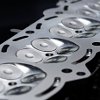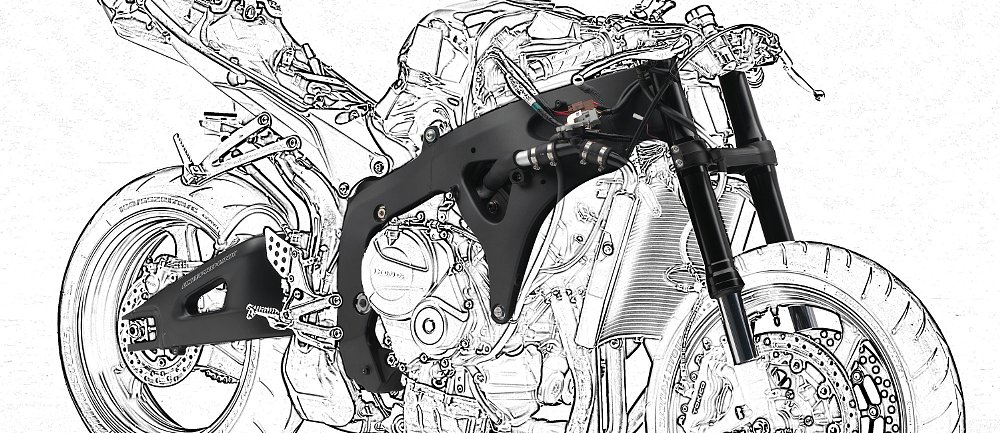Do you know how many valves your bike has? Does it matter? Have you ever wondered how “they” figure out how many valves go in your engine?
Poppet valves admit air and fuel into your bike’s engine (intake valves), and allow spent exhaust gas to escape (exhaust valves). In the case of exhaust valves, they also help transfer some of the heat from the combustion chamber into the head via the valve seats.

In the early days, most motorcycles were either IOE (intake-over-exhaust) or side-valve engines. The engines worked well for the time, but had some performance drawbacks. Because there were no valves on top of the cylinder, they were called "flathead" engines. They were tough and reliable, but they failed to make much horsepower, for a few reasons.
With the valves off to the side, the flathead's combustion chamber shape was pretty inefficient. They usually had very low compression ratios (the ratio of the volume of the combustion chamber at the bottom of the piston’s stroke relative to the top of it, or how much the air-fuel mixture is “squeezed” to make a more powerful explosion). The other problem with the flathead’s design was that with the intake and exhaust valves right next to each other, the air-fuel mixture and exhaust gases had to take a fairly tortuous route. The more bends and turns, the harder the engine must work to fill and empty itself.
Of course both overhead-valve (OHV) engines, and even multi-valve versions, were also around from early on. Harley-Davidson built an eight-valve OHV V-twin for racing in the 1910s. The main advantage it offered was, surprisingly, longevity. Eight little valves dissipated heat better than four big ’uns. This helped Harley finish races, which was the first step to winning them in the old days. Speed usually came second to reliability.
As time wore on, metallurgy improved, and so did fuel. Gasoline was no longer a shaky, who-knows-what witch's brew of dog farts and petroleum. These two factors contributed to the dominance of OHV engines because they finally allowed compression ratios that were sky-high, compared to those antique flatheads. It didn’t hurt, of course, that the OHV motors were able to make good power at higher speeds, unlike their flathead counterparts. Early street OHV engines, for the most part, were two-valvers: each cylinder had an intake and an exhaust valve, because it was a simple, inexpensive layout.
The quest to get more air and fuel into the engine marched on. Increasing the depth to which a valve opened or the duration it stayed open had practical limits, due to the timing of the piston's movement. Engineers discovered they could achieve better flow through the head by simply increasing the number of valves.


A greater number of smaller valves increases the total valve area. A two-valve, OHV engine is able to utilize roughly 50 percent of available valve area. (Roughly. These are calculations based off of simple geometry.) A well designed, four-valve head should be able to bump that number to almost 70 percent. That increase is nothing to sniff at!
Here's the drawback: Operating all those valves is a bit of an engineering nightmare! Good luck actuating all those valves with one camshaft in the block and some pushrods. Moving all those valves at the right times in an OHV setup is tricky. That’s one reason why four-valve pushrod engines are about as rare as unicorn meat. (The Honda CX series is a notable exception.)

Due to that complexity, multi-valve heads happened concurrently with the rise of overhead-cam (OHC) and double-overhead-cam (DOHC) engines. Actuating lots of valves was made simpler by locating the cam(s) above the valves and opening and closing them directly. Multiple pushrods or complicated linkages were replaced by a simple belt or chain (or, in the case of older Honda VFRs, quite a few gears) to turn the camshaft. The switch to overhead cams also allowed more precise valve control, but that’s a story for another time. Still, it bears mention because it was one more nail in the coffin for OHV designs.

Multi-valve heads became common in most motorcycles because the larger number of smaller valves provides more surface area and allows greater power, and overhead cams work well with multi-valve heads, so the two go hand in hand. Two-valve heads are still used in cases where maximum top-end power is not the primary goal. One trade-off for the greater power is greater complexity. As with many things in life, power and simplicity are often conflicting goals.
Like most of these "why things are" articles, there's no one way that's "right" and another that's "wrong." It's all about matching the technology with the goal. When the goal is big, high-revving power from a small-displacement engine, that means multiple valves. And that's why things are the way they are.

















